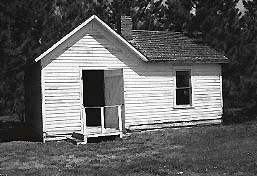Historic Architectural Survey of Bowman County
Homestead Shanties on the Move
On a twentieth-century, railroad-based frontier, the sod house was not the norm for pioneer dwellings. Lumber, tarpaper, shingles, and other building materials were readily available, and it was much easier to erect some sort of frame shelter than to cut sod. The rudest residences were tarpaper shanties--frame boxes with tarpaper and lath nailed to the exterior--but even these might be improved over time, adding siding and windows. The homestead shanty was not regarded as a permanent fixture. It was erected for the purpose of proving up a claim, that is, satisfying government requirements for residence and improvements. After that it would be replaced, improved, or removed. Scores of these shanties still stand in Bowman County. The ones still standing intact, rather than as part of some larger aggregate building, have all been relocated and put to some purpose other than residence.
 | Carl W. "Billy" Lindros homesteaded just across the line in South Dakota, a neighbor to Maria C. Carlson. When the two of them had proved up their claims, they got married and moved their two homestead shanties together, resulting in the building here depicted. It has been moved onto the Rosalie and Neil Krinke farm, where it is preserved as a sort of private museum. |
| The Krinkes also have moved a second homestead shanty onto their place and used it for storage. This shanty was stuccoed to make a tighter residence than the original, drafty claim shanty. |  |
 | The last postmaster of Haley moved two homestead shanties into the town site. This one (left) was modest indeed--a small, shed-roofed building with door and windows on only one side. |
| Slightly more expansive was this second (right), gable-roofed shanty also moved to Haley. |  |
 | The railroad town of Buffalo Springs has largely disappeared, but in the middle of what once was Buffalo Springs stands this interesting building. It comprises two tarpaper shacks moved together and roughly stuccoed into a single building that was once used as a restaurant. |
| Moved onto the old Griffith town site and used as a tool shed is this old homestead shanty (left). The vaulted tin roof, while not uncommon for homestead shanties in the region, is the only one noted during the survey of Bowman County. |  |
 | The modest but fairly comfortable shanty at right was used to prove up a claim in the Grand River valley and then was moved onto a neighboring farm to be used for storage. |
| Another shanty in the area (left) is slightly larger and boasts more substantial windows, indicating a little better economic circumstances at the outset, but the metal stovepipe indicates something less than a sense of permanence. |  |
 | This final shanty, with its brick chimney, is just about as substantial and commodious as homestead shanties got, and likely served as a residence for a generation or more after settlement. |
 Center for Heritage Renewal
Center for Heritage Renewal
|